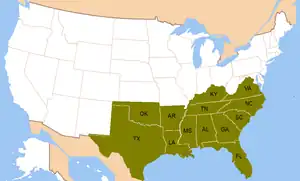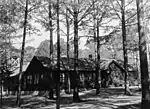Southern Research Station
The Southern Research Station (SRS) is one component of seven units that provide the framework for the US Forest Service (USFS) Research and Development organization.[3] Forest Service R&D is described as "...the most extensive natural resources research organization in the world".[4]
 Logo of the US Forest Service. | |
| Agency overview | |
|---|---|
| Formed | 1921[1] |
| Jurisdiction | Federal Government of the United States |
| Headquarters | 200 W.T. Weaver Blvd., Asheville, NC 28804-3454 |
| Agency executive |
|
| Parent agency | US Department of Agriculture United States Forest Service |
| Website | srs.fs.usda.gov |
Mission
The mission of the Southern Research Station is:
...to engage in high-quality research leading to the scientific and technological advances needed to sustain and enhance forest ecosystems and the full range of benefits they provide.[5]
History
The R&D organization has been part of the USFS mission since the agency was created in 1905.[6] As one of seven units in the USFS R&D organization, the Southern Research Station had its beginnings as two separate entities – the Southern Forest Experiment Station and the Southeastern Forest Experiment Station.[7] During their formative years, major areas of research in these two experiment stations included:[8]
- Mensuration
- Growth & yield
- Harvest and reproduction cutting methods
- Gum naval stores production
- Thinning research in even-aged, second-growth loblolly and shortleaf pine stands
- Forest fire research
Southern Forest Experiment Station (SFES)
Initiated in 1921, the SFES was responsible for research in southern pine types within the states of South Carolina, Georgia, Florida, Alabama, Mississippi, Louisiana, East Texas and southern Arkansas.[8] The SFES was headquartered in New Orleans, LA.[9]
Southeastern Forest Experiment Station (SEFES)
The SEFES began as the Appalachian Station in 1921,[4] with its research scope being generally limited to mountain hardwood types.[8] States within the Appalachian Station included North Carolina, South Carolina, northern Georgia, Virginia, West Virginia, eastern Kentucky, and eastern Tennessee.[10] After World War II, the Appalachian Station was redesignated as the Southeastern Forest Experiment Station, and research was expanded to include both pine and hardwood types from Florida through Virginia.[1] Headquarters for the Appalachian Station and SEFES were in Asheville, NC.[11]
Southern Research Station (SRS)
In 1995, the Southern and Southeastern Forest Experiment Stations merged to form the Southern Research Station with headquarters in Asheville, NC.[7] Research was expanded into new fields to address "...how climate change, human population growth, invasive plants, pathogens, and fire affect the provision of timber, wildlife, clean air and water, and recreation, as well as other ecosystem services."[7]
Thirteen US states are located within the boundary of the Southern Research Station.[12]

- Alabama
- Arkansas
- Florida
- Georgia
- Kentucky
- Louisiana
- Mississippi
- North Carolina
- Oklahoma
- South Carolina
- Tennessee
- Texas
- Virginia
SRS Science Centers and Research Work Units
As of 2022, SRS research activities were being conducted within 15 Research Work Units located throughout the southeastern US and were categorized under four scientific objectives or science centers.[13]
| Science Center | Research Work Unit and contact location |
|---|---|
| Forest Assessment and Synthesis | •Center for Forest Watershed Research (Otto, NC) •Forest Economics and Policy (Research Triangle Park, NC) •Eastern Forest Environmental Threat Assessment Center (Asheville, NC and Research Triangle Park, NC) •Center for Integrated Forest Science (Raleigh, NC) •Integrating Human and Natural Systems (Athens, GA and Gainesville, FL) |
| Forest Health and Disturbance | •Center for Forest Disturbance Science (Athens, GA and Clemson, SC) •Forest Genetics and Ecosystems Biology (Saucier, MS) •Insects, Diseases and Invasive Plants of Southern Forests (Athens, GA) |
| Forest Inventory and Analysis | •Forest Inventory and Analysis (Knoxville, TN) |
| Forest Restoration and Management | •Center for Bottomland Hardwoods Research (Stoneville, MS) •Upland Hardwood Ecology and Management (Asheville, NC) •Restoring and Managing Longleaf Pine Ecosystems (Monticello, AR) •Southern Pine Ecology and Management (Monticello, AR) •Forest Operations (Auburn, AL) •Utilization of Southern Forest Resources (Auburn, AL) |
SRS Experimental Forests
Within the SRS, there are 20 Experimental forests and/or Rangelands located in nine southeastern states.[14] These experimental forests and rangelands provide a network for conducting long-term research studies and are a treasure trove of accumulated historical sampling data that span a time period of up to 100 years. Experimental forests also serve as education and demonstration sites where researchers interact with students, forest landowners, and forest managers.[15]
| Experimental forest | Size (acres) | Location US State | Year established |
|---|---|---|---|
| Escambia | 2,990 | Alabama | 1947 |
| Alum Creek | 4,281 | Arkansas | 1959 |
| Crossett | 1,675 | Arkansas | 1934 |
| Henry R. Koen | 720 | Arkansas | 1951 |
| Sylamore | 4,290 | Arkansas | 1934 |
| Chipola | 2,760 | Florida | 1934 |
| Olustee | 3,135 | Florida | 1934 |
| Hitchiti | 4,602 | Georgia | 1938 |
| Scull Shoals | 4,487 | Georgia | 1961 |
| Palustris | 7,515 | Louisiana | 1935 |
| Experimental forest | Size (acres) | Location US State | Year established |
|---|---|---|---|
| Delta | 2,580 | Mississippi | 1961 |
| Harrison | 4,111 | Mississippi | 1934 |
| Tallahatchie | 4,569 | Mississippi | 1950 |
| Bent Creek | 5,242 | North Carolina | 1925 |
| Blue Valley | 1,400 | North Carolina | 1964 |
| Coweeta | 5,482 | North Carolina | 1934 |
| John C. Calhoun | 5,082 | South Carolina | 1947 |
| Hill Demo Forest | 2,690 | North Carolina | 1947 |
| Santee | 6,000 | South Carolina | 1937 |
| Stephen F. Austin | 2,560 | Texas | 1945 |
Research Natural Areas
In 2022, there were 33 established Research Natural Areas (RNA) located within 12 southeastern US states, excluding Tennessee.[16] At least two Research Natural Areas are located within the boundaries of the Southern Research Station's Experimental Forests:
- The Harrison Research Natural Area is located within the Harrison Experimental Forest.[17] This portion of the experimental forest contains 180 acres (73 ha) that were designated as a RNA in 1989.[17] When assessed in 1991, the overstory component within this RNA was 90% longleaf pines (Pinus palustris) that established naturally from seeds after the virgin pine forests were clearcut in the 1920s.[17]
- The R. R. Reynolds Research Natural Area is located within the Crossett Experimental Forest.[18][19] Other than fire protection, the R.R. Reynolds RNA was set aside from active forest management in 1943 to provide a contrast to managed stands.[18][19] Based on a 1993 tree inventory, the RRRRNA was described as "... a closed–canopy, mature loblolly pine (Pinus taeda)–hardwood forest", with oaks (Quercus spp.) being the predominant overstory hardwood component.[18][19] This 80-acre (32 ha) forest area was designated as a RNA in 2005.[20]
Gallery
SRS Crossett Experimental Forest headquarters timeline
This 60-year pictorial timeline is indicative of the USFS commitment to maintaining the infrastructure needed to support long-term forest research.
 November 1936
November 1936 April 1959
April 1959 February 1979
February 1979 February 2000
February 2000
See also
References
- Josephson, H.R. 1989. A History of Forestry Research in the Southern United States. USDA Forest Service, Miscellaneous Publication No. 1462
- "Patel-Weynand Named Director of Southern Research Station | News and Events | SRS". srs.fs.usda.gov. Retrieved July 3, 2022.
- "USDA Forest Service Southern Research Station". www.srs.fs.usda.gov. Retrieved July 3, 2022.
- "The Southern Research Station | Strategic Framework | About Us | SRS". www.srs.fs.usda.gov. Retrieved July 16, 2022.
- "Strategic Framework | About Us | SRS". www.srs.fs.usda.gov. Retrieved July 16, 2022.
- "Home". US Forest Service Research and Development. January 3, 2022. Retrieved July 3, 2022.
- "The Southern Research Station | Strategic Framework | About Us | SRS". www.srs.fs.usda.gov. Retrieved July 4, 2022.
- Wakeley, Philip C. (1964). "A Biassed [sic] History of the Southern Forest Experiment Station Through Fiscal Year 1933" (PDF). srs.fs.usda.gov. Retrieved July 3, 2022.
- "WorldCat Identities|Southern Forest Experiment Station (New Orleans, La.)". worldcat.org. Retrieved July 4, 2022.
- "US Forest Service Photographs". toto.lib.unca.edu. Retrieved July 3, 2022.
- "WorldCat Identities|Southeastern Forest Experiment Station (Asheville, N.C.)". worldcat.org. Retrieved July 4, 2022.
- "Locations | Southern Research Station". www.srs.fs.usda.gov. Retrieved July 26, 2022.
- "Research Centers and Work Units | Locations | SRS". www.srs.fs.usda.gov. Retrieved July 8, 2022.
- "Experimental Forests and Ranges (EFR) Network | Locations | SRS". www.srs.fs.usda.gov. Retrieved July 7, 2022.
- Farmer, Sarah; Communications, SRS Science. "New story map for the Experimental Forest Network". CompassLive. Retrieved July 9, 2022.
- "Research Natural Areas | SRS". www.srs.fs.usda.gov. Retrieved July 25, 2022.
- Devall, Margaret (2016). "Research Natural Areas | SRS| Harrison RNA". www.srs.fs.usda.gov. Retrieved July 25, 2022.
- Long, Mary Mallinson (2016). "Research Natural Areas | SRS| R.R. Reynolds RNA". www.srs.fs.usda.gov. Retrieved July 25, 2022.
- "R.R. Reynolds Research Natural Area". fs.usda.gov. Retrieved June 8, 2023.
- "Established Research Natural Areas | Research Natural Areas in the Southern Region | SRS". www.srs.fs.usda.gov. 2016. Retrieved July 25, 2022.